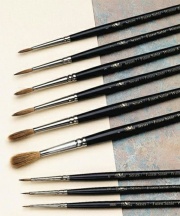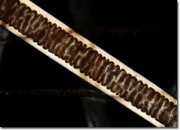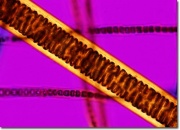Difference between revisions of "Kolinsky"
(username removed) |
|||
| (7 intermediate revisions by 4 users not shown) | |||
| Line 2: | Line 2: | ||
== Description == | == Description == | ||
| − | The reddish-brown hair from the tails of an Eurasian mink, Mustela siberica and Mustela lutreola, native to Siberia, Manchuria, China, and Japan. Artist brushes made from kolinsky tail hairs are called kolinsky or red sable brushes. These valuable brushes have excellent resilience and spring. The hair obtained from the male animals in winter is most prized for the brushes because it is longer and more tapered. To decrease costs, the long hairs are sometimes mixed with shorter hairs from the female minks or even with [ | + | The reddish-brown hair from the tails of an Eurasian mink, ''Mustela siberica'' and ''Mustela lutreola'', native to Siberia, Manchuria, China, and Japan. Artist brushes made from kolinsky tail hairs are called kolinsky or red sable brushes. These valuable brushes have excellent resilience and spring. The hair obtained from the male animals in winter is most prized for the brushes because it is longer and more tapered. To decrease costs, the long hairs are sometimes mixed with shorter hairs from the female minks or even with [[ox hair]] or synthetic fibers. These mixed fibers often have an unnatural bright orange tint (Z. Pinney 1999). |
| + | [[File:kolinsky1large.jpg|thumb|Kolinsky hair]] | ||
| + | [[File:kolinskylarge.jpg|thumb|Kolinsky hair]] | ||
| − | |||
== Synonyms and Related Terms == | == Synonyms and Related Terms == | ||
| − | kolinsky sable; red sable; red Tartar marten; Siberian mink; China mink; kolinski; Mustela siberica; Mustela lutreola | + | kolinsky sable; red sable; red Tartar marten; Siberian mink; China mink; kolinski; ''Mustela siberica''; ''Mustela lutreola'' |
| − | |||
| − | |||
| − | |||
| − | |||
| − | |||
| − | |||
| − | |||
| − | |||
| − | |||
| − | |||
| − | |||
| − | |||
| − | + | == Physical and Chemical Properties == | |
| − | == | ||
| − | + | * Brownish red hair with yellowish tint | |
| + | * Length ranges from 1.75 to 2.25 inches | ||
| + | * Hair tapers at both ends to a needle sharp point at tip; the belly is about one-third of the hair's length from the butt end. | ||
| + | * Density = 1.0-1.13 | ||
| − | == | + | == Resources and Citations == |
| − | * | + | * F. Kidd, ''Brushmaking Materials'', Bristish Brush Manufacturers, London, 1957 |
| − | * | + | * Zora Sweet Pinney, 'A Handle on the Terms used for Artists' Brushes', unpublished glossary, 1999 |
| − | * | + | * Ralph Mayer, ''A Dictionary of Art Terms and Techniques'', Harper and Row Publishers, New York, 1969 (also 1945 printing) |
| − | * | + | * Edward Reich, Carlton J. Siegler, ''Consumer Goods: How to Know and Use Them'', American Book Company, New York City, 1937 |
| − | * ''Encyclopedia Britannica'', http://www.britannica.com Comment: "kolinsky" | + | * ''Encyclopedia Britannica'', http://www.britannica.com Comment: "kolinsky" [Accessed October 16, 2003]. |
| − | * Wikipedia | + | * Wikipedia: http://en.wikipedia.org/wiki/Kolinsky (Accessed Nov. 9, 2005) |
| − | * | + | * Random House, ''Webster's Encyclopedic Unabridged Dictionary of the English Language'', Grammercy Book, New York, 1997 |
* ''The American Heritage Dictionary'' or ''Encarta'', via Microsoft Bookshelf 98, Microsoft Corp., 1998 | * ''The American Heritage Dictionary'' or ''Encarta'', via Microsoft Bookshelf 98, Microsoft Corp., 1998 | ||
Latest revision as of 13:05, 5 October 2022
Description
The reddish-brown hair from the tails of an Eurasian mink, Mustela siberica and Mustela lutreola, native to Siberia, Manchuria, China, and Japan. Artist brushes made from kolinsky tail hairs are called kolinsky or red sable brushes. These valuable brushes have excellent resilience and spring. The hair obtained from the male animals in winter is most prized for the brushes because it is longer and more tapered. To decrease costs, the long hairs are sometimes mixed with shorter hairs from the female minks or even with Ox hair or synthetic fibers. These mixed fibers often have an unnatural bright orange tint (Z. Pinney 1999).
Synonyms and Related Terms
kolinsky sable; red sable; red Tartar marten; Siberian mink; China mink; kolinski; Mustela siberica; Mustela lutreola
Physical and Chemical Properties
- Brownish red hair with yellowish tint
- Length ranges from 1.75 to 2.25 inches
- Hair tapers at both ends to a needle sharp point at tip; the belly is about one-third of the hair's length from the butt end.
- Density = 1.0-1.13
Resources and Citations
- F. Kidd, Brushmaking Materials, Bristish Brush Manufacturers, London, 1957
- Zora Sweet Pinney, 'A Handle on the Terms used for Artists' Brushes', unpublished glossary, 1999
- Ralph Mayer, A Dictionary of Art Terms and Techniques, Harper and Row Publishers, New York, 1969 (also 1945 printing)
- Edward Reich, Carlton J. Siegler, Consumer Goods: How to Know and Use Them, American Book Company, New York City, 1937
- Encyclopedia Britannica, http://www.britannica.com Comment: "kolinsky" [Accessed October 16, 2003].
- Wikipedia: http://en.wikipedia.org/wiki/Kolinsky (Accessed Nov. 9, 2005)
- Random House, Webster's Encyclopedic Unabridged Dictionary of the English Language, Grammercy Book, New York, 1997
- The American Heritage Dictionary or Encarta, via Microsoft Bookshelf 98, Microsoft Corp., 1998


